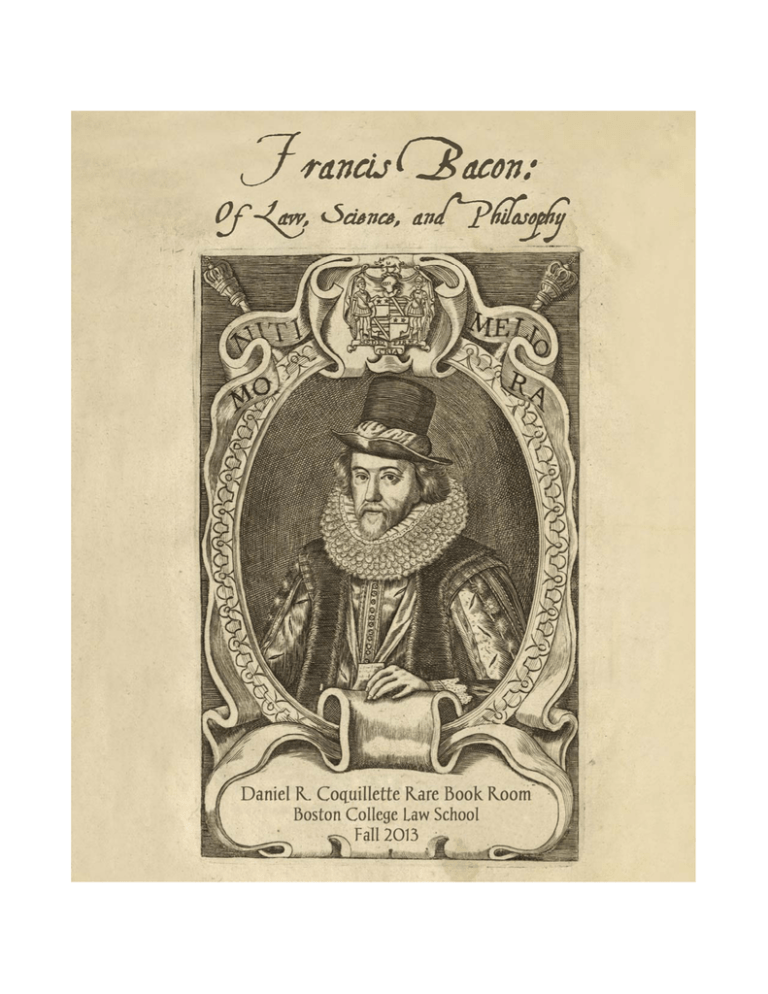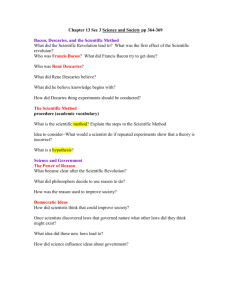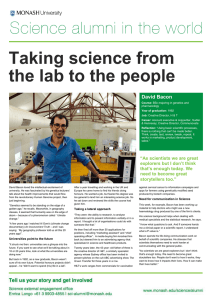1
advertisement

1 Francis Bacon: Of Law, Science, and Philosophy Boston College Law Library Daniel R. Coquillette Rare Book Room Fall 2013 This exhibit was curated by Laurel Davis and features a selection of books from a beautiful and generous gift to us from J. Donald Monan Professor of Law Daniel R. Coquillette The catalog cover was created by Lily Olson, Law Library Assistant, from the frontispiece portrait in Bacon’s Of the Advancement and Proficiencie of Learning: Or the Partitions of Sciences Nine Books. London: Printed for Thomas Williams at the Golden Ball in Osier Lane, 1674. The caption of the original image gives Bacon’s official title and states that he died in April 1626 at age 66. Many thanks to Lily for her work on the catalog. THE LIFE OF FRANCIS BACON Francis Bacon (Baron Verulam and Viscount St. Albans,1551-1626) remains one of the most fascinating and controversial figures in English history. Though he would later become Lord Chancellor of England, Bacon grew up in relative poverty as the largely disinherited son of Sir Nicholas Bacon, Lord Keeper under Queen Elizabeth I. He received most of his early schooling at home before attending Trinity College, Cambridge, and then entering Gray’s Inn, where he was admitted to the bar in 1582 and elected as a reader in 1587. Bacon earned his first seat in Parliament in 1581 at twenty years old and quickly made a name for himself as a critic of Catholics both inside and beyond the bounds of England and as a supporter of the Puritan cause. Indeed, he argued for the execution of Mary, Queen of Scots. In the 1590s, Bacon continued his life in politics and the law and attempted to gain the position of attorneygeneral. The post (along with the young and rich Lady Elizabeth Hatton) was ultimately taken by Bacon’s rival, Edward Coke. During this time, Bacon began to develop his interest in natural philosophy and also pursued his ideas on reforming English law. This led to the publication of his MAXIMES OF THE COMMON LAW, dedicated to Queen Elizabeth and urging the restructuring of the English legal system. When James I took the throne in 1608, Bacon actively sought his favor and was rewarded with a knighthood and granted the office of learned counsel. He continued to be an active member of Parliament and to write tracts on a variety of topics, including law, politics, and religion. In June 1607, Bacon became solicitor-general and soon the clerk of the Star Chamber, both of which helped him achieve some semblance of financial security. In the period between 1607 and 1611, Bacon began to conceive his entire philosophical plan (which he called the INSTAURATIO MAGNA) as consisting of six parts. He also wrote his many of his best known legal works around this time, including writings on Scottish unification, an issue of great interest to James I. Finally, in 1613, Bacon achieved his long-held wish and became attorneygeneral, and he defended the king in numerous legal cases in that post. Ultimately, in 1618, Bacon took the office of Lord Chancellor and was raised to the peerage and created Baron Verulam of Verulam, which he styled himself thereafter. Bacon’s fortunes took a bad turn in 1621, when he was impeached for accepting judicial bribes. The original attack certainly was orchestrated by Edward Coke, at least in part. Bacon confessed to accepting bribes but claimed (truthfully) that they did not affect his decisions in the trials. Bacon was imprisoned in the Tower of London for a few days, but most importantly, he was barred from any government office, thereby losing his seat as Lord Chancellor and his position in Parliament. After his impeachment, Bacon continued writing, focusing largely on his INSTAURATIO MAGNA, which is discussed later in the exhibit. He also published his history of Henry VII in 1622. Perhaps most famously, he toiled away on his utopian work, THE NEW ATLANTIS, and the natural history work SYLVA SYLVARUM, which were published together posthumously in 1626. BACON’S ESSAYES This is one of Bacon’s most famous and oft published works. ESSAYES, which was actually the first of his works to be printed (earlier works had circulated in manuscript), originally contained ten essays. In the second edition of 1612, Ba2 con expanded the number to 38, including “Of Judicature,” reflecting his rise to the bench. Bacon’s final version contained fifty-eight. Each of the first three books displayed here contain all 58 essays. The last book in this section, AN ESSAY ON GARDENS, is a handwritten transcription of that one essay. In ESSAYES, Bacon pontificates on a wide range of matters—atheism, friendship, gardens, love, superstition, etc.—and offers his observations and advice. It is characterized by a multitude of examples, quotations, and aphorisms, many quite famous. For example, “Of Boldness” represents the earliest known appearance of the concept “If the hill will not come to Mahomet, Mahomet will go to the hill.” FRANCIS BACON, THE ESSAYES don, 1629. OR COUNSELS, CIVILL AND MORALL. Lon- There is tremendous breadth in the subjects covered in this work—death, revenge, cunning, love, travel, deformity, etc. This edition contains all 58 essays, including “Of Judicature” and “Of Gardens.” FR. BACONI DE VERULAMIO, SERMONES FIDELES, ETHICI, POLITICI, ECONIMICI. Amsterdam, 1662. Soon after Bacon died, his loyal secretary and chaplain, William Rawley, translated the THE ESSAYES into Latin as SERMONES FIDELES. Pictured to the right, this beautiful little book, with a gorgeous title page, was printed by the famed Elzevir press in The Netherlands. 3 FRANCIS BACON, ESSAYS, MORAL, ECONOMICAL, AND POLITICAL. London, 1807. C.M.D, AN ESSAY CIS BACON. 1912. ON GARDENS BY FRAN- This manuscript was done in elegant calligraphy by “C.M.D.” in red and black ink. The lovely little book is inscribed to a Mrs. E. Wrigley by the famous Bacon bibliographer R.W. Gibson. It is a slim little volume, bound in red leather, with a gilt embossed title. BACON THE LAWYER Though better known by many today as a scientist and philosopher, Francis Bacon was an important lawyer and jurist. He served as counsel to Queen Elizabeth and James I and held the positions of solicitor-general, attorney-general, and Lord Chancellor. Though trained and self-identified as a common lawyer, Bacon often looked to civilian sources as possible inspiration for legal reform; he was also more willing than many of his nationalistic colleagues to look to foreign sources for inspiration and guidance. Most famously, Bacon’s authoritarian approach (including advocating the role of torture to obtain evidence) to governing made him the enemy of many common lawyers, most notably Edward Coke. 4 FRANCIS BACON, THE ELEMENTS OF THE COMMON LAWES OF ENGLAND, BREACHED INTO A DOUBLE TRACT: THE ONE CONTAINING A COLLECTION OF SOME PRINCIPALL RULES AND MAXIMES OF THE COMMON LAW… London, 1639. This is the earliest of Bacon’s legal texts, though it was not published until 1631, well after his death. It consists of a selection of twenty-five maxims from common law and civilian sources, briefly stated by Bacon and then followed by an analysis of the maxim, complete with examples and exceptions. Though rather disjointed and often mysterious, THE MAXIMES has been recognized as one of the first English legal works to delve into policy considerations behind existing legal doctrines. THE LEARNED READING OF SIR FRANCIS BACON, ONE OF HER MAJESTIES LEARNED COUNSELL AT LAW, UPON THE STATUTE OF USES…London, 1642. Learned lawyers, such as Bacon, would give lectures on law at their Inn of Court. One “reading” was usually a series of lectures on a given statute. Bacon selected the Statute of Uses (1536) for the topic of his reading at Gray’s Inn in 1600. In 1595, Bacon had appeared in a case involving that statute called Dillon v. Freine or Chudleigh’s Case. The controversial statute, passed during the reign of Henry VIII, aimed at limiting the influences of “uses”—a use is a legal device that is an ancestor of modern trusts. Common lawyers dedicated a hefty amount of time to circumventing the letter of the statute, 5 and, by Bacon’s time, the landscape was confused and rife with controversy. The surviving record of Bacon’s six-day reading is incomplete, but the portion that remains shows Bacon engaged in an impressive feat of statutory interpretation, as he discusses the historical context and policy considerations behind the statute’s enactment. A SPEECH DELIVERED BY SIR FRANCIS BACON, IN THE LOWER HOUSE OF PARLIAMENT QUINTO JACOBI, CONCERNING THE ARTICLE OF NATURALIZATION OF THE SCOTTISH NATION. London, 1641. James I actively supported the union of Scotland with England, and Bacon wrote in support of unification (which ultimately would not happen until 1706). Professor Coquillette has written that Scotland’s civilian traditions gave Bacon the opportunity to compare English legal institutions to continental civil law, and that his writings on Scottish unification allowed him to promote his views of law reform and the proper sources of law. BACON’S POLITICAL GOLDEN YEARS In June 1607, Bacon finally gained a crown office when he was appointed solicitor-general, and then in 1608 he became the clerk of the Star Chamber. Around this same time, Bacon also wrote his first works employing the absolutist principles that made him the enemy of common lawyers like Edward Coke. Bacon 6 insisted that while some of the king’s power were given to him by the common law and could be disputed in the courts, others derived from God as his sovereign power and could not be infringed upon by judges. Finally, in 1613, King James gave Bacon his long-desired post of attorneygeneral. In this post, Bacon continued his battle with Edward Coke, who Bacon had demoted from his chief justice position in the Court of Common Pleas to the King’s Bench in 1613. Bacon then played an important role in Coke’s removal from the King’s Bench and the privy council in 1616. In 1618, Bacon took the office of Lord Chancellor. He was raised to the peerage and became Baron Verulam of Verulam, a title he would wear proudly until his death. As the most powerful lawyer in the country, Bacon handled routine matters in the Court of Chancery where he focused on expediency and fairness. He also handled more public and memorable cases, delivering the sentence of execution to Sir Walter Raleigh and prosecuting well-known public figures in the Star Chamber. SIR FRANCIS BACON, CASES OF TREASON. London, 1641. In this posthumously published work, Bacon discusses crimes that constitute treason, including if “any Jesuite, or any other Priest ordained since the first yeere of the reigne of Queene Elizabeth, shall come into, or remaine in any part of this Realme.” He touches on jurisdictional issues and lists the various punishments for the commission of treasons, while also distinguishing felonies that do not rise to the level of treason. 7 THE CHARGE OF SIR FRANCIS BACON KNIGHT, HIS MAJESTIES ATTOURNEY GENERALL, TOUCHING DUELLS… London, 1614. Bacon became attorney-general in 1613, and one of his first tasks was to abolish the practice of dueling. In this speech to Parliament, he proposed that offenders be prosecuted in the Star Chamber, arguing that “men of birth and quality will leave the practice when it begins to be vilified, and come so low as to barber-surgeons and butchers, and such base mechanical persons.” ORDINANCES MADE BY THE RIGHT HONOURABLE SIR FRANCIS BACON… FOR THE BETTER AND MORE REGULAR ADMINISTRATION OF JUSTICE IN CHANCERY…London, 1642. While Bacon is likely not responsible for this entire work, his influence is clear in this set of rules governing practice in the High Court of Chancery. As Lord Keeper of the Seal and then Lord Chancellor, Bacon was the official head of the equitable Chancery Court. One of Bacon’s legacies to the legal profession is an insistence on clear rules of procedure as a mechanism for expediency and fairness. Among many other topics, THE ORDINANCES discusses the need to limit jurisdictional conflicts and to eliminate frivolous suits. BACON, SCIENTIST AND PHILOSOPHER To many, Francis Bacon is perhaps better known as a scientist and philosopher than as a jurist. He is often credited as the inventor of the modern scientific method and known for his theory of inductive scientific reasoning and his insist8 ence on the direct observation of nature (working from specific observations toward generalizations, as opposed to Aristotelian deductive reasoning where one works backwards from a general statement). THE TWO BOOKES OF FRANCIS BACON. OF THE PROFICIENCE VANCEMENT OF LEARNING, DIVINE AND HUMANE. London, 1605. AND AD- This is the pristine first edition of Bacon’s first published philosophical work, commonly known as THE ADVANCEMENT OF LEARNING. The first part lays out Bacon’s view of the value of knowledge and his belief that it is not dangerous or sacrilegious but rather useful and divine. The second part moves into the ways in which true knowledge should be sought and secured, namely by devoting more money, facilities, and personnel to contemporary education. A key and controversial point in this work is Bacon’s assertion that empirical research lies at the core of natural and human philosophy. FRANCISCI BACONI, DE SAPIENTIA VETERUM. London, 1617. First published in 1609, this is a collection of classical fables summarized and interpreted by Bacon and used a vehicles for his political and philosophical ideas. Traditionally categorized with his literary pieces, this work recently has been viewed as critical to Bacon’s thinking on natural and civil philosophy. SIR FRANCIS BACON, THE WISEDOM THE ANCIENTS. London, 1619. OF This is an early edition in English of DE SAPIENTIA VETERUM. The picture to the right shows the beautifully ornamented opening page of text. 9 BACON’S INSTAURATIO MAGNA One of Bacon’s great intellectual goals was to complete a grand philosophical work that he called the INSTAURATIO MAGNA (or “Great Renewal of Learning”). In the end, Bacon did not finish the work, but he did outline a sixpart plan and much of it was filled in by his writings. The first part was to be on the Division of the Sciences or “Partitiones Scientiarum,” the goal of which was to survey the present state of knowledge and prepare the reader’s mind for a new method of learning based on direct observation and induction. Originally published in 1605 with two “books” or parts, THE ADVANCEMENT OF LEARNING ultimately was expanded by Bacon into nine books and published in Latin. That expansion is known as DE AUGMENTIS and is represented in this exhibit by two subsequent English editions. With this work, Bacon completed the first part of his INSTAURATIO MAGNA. The other works featured in this section also form crucial pieces of that great philosophical plan. FRANCIS BACON, OF THE ADVANCEMENT AND PROFICIENCIE OF LEARNING: OR THE PARTITIONS OF SCIENCES NINE BOOKS. London, 1674. The frontispiece portrait shown above is from this volume—it is the image used on the cover of this catalog, with the caption modified. 10 FRANCIS BACON, OF THE ADVANCEMENT AND PROFICIENCE OR THE PARTITIONS OF SCIENCES IX BOOKES. Oxford, 1640. OF LEARNING: This is an edition in English of Bacon’s expanded ADVANCEMENT OF LEARNING (DE AUGMENTIS). The work includes detailed outlines or diagrams of the contents of the nine books contained within it. In the outline for Book Two, Bacon notes that learning is promoted by good facilities, books (libraries and ‘good editions’), and funds to pay good lecturers. FRANCISCI BACONI, OPERUM MORALIUM 1638. ET CIVILIUM TOMUS. London, This impressive tome, which includes many of Bacon’s major works, is particularly notable for the work appended at the end: his NOVUM ORGANUM. Here, Bacon urges the replacement of Aristotelianism with an inductive method based on observation of nature itself. It includes reports on many of Bacon’s chemical and mechanical experiments. FRANCIS LORD VERULAM, VISCOUNT S. ALBAN, THE HISTORIE OF LIFE AND DEATH. WITH OBSERVATIONS NATURALL AND EXPERIMENTALL FOR THE PROLONGING OF LIFE. London, 1638. This work is a piece of the Natural Histories part of Bacon’s planned INSTAURATIO MAGNA. Bacon was long obsessed with immortality and viewed the achievement of the prolongation of life as one of the “true ends of knowledge.” The captions to the illustrations on the gorgeous half-title page are “Art can flay Nature’s decay”; “Let time Looke on this booke”; “To death all…”; “At last fall.” 11 FRANCISCI BACONI DE VERULAMIO, SCRIPTA IN NATURALI ET UNIVERSALI PHILOSOPHIA. Amsterdam, 1653. This lovely book contains a collection of Bacon’s works on natural philosophy. BACON’S LATER WORKS Bacon’s fortunes took a bad turn in 1621, when he was impeached for bribery. Ultimately, he confessed and was fined and imprisoned for a short time in the Tower of London. Most importantly, he lost his seat as Lord Chancellor. After his impeachment, Bacon continued writing, focusing largely on his INSTAURATIO MAGNA. He also published his history of Henry VII in 1622 and toiled away on his utopian work, the NEW ATLANTIS. FRANCIS, LORD VERULAM, VISCOUNT ST. ALBAN, THE HISTORIE OF THE RAIGNE OF KING HENRY THE SEVENTH. London, 1622. This political history is notable to theorists who think Bacon wrote Shakespeare’s plays, as there is no Shakespeare work on Henry VII and this work picks up where Richard III ends. Professor Coquillette rejects that theory, but says this work fits in with the Natural Histories portion of the INSTAURATIO MAGNA and reflects Bacon’s deep admiration for the great Tudor monarchs. 12 FRANCIS LO. VERULAM VISCOUNT ST ALBAN, SYLVA SYLVARUM: OR, A NATURALL HISTOIRE. IN TEN CENTURIES. London, 1639. SYLVA SYLVARUM (“Forest of Forests”) is an exhaustive list (1000 entries) of Bacon’s natural observations on all sorts of things from gravity to the tenderness of teeth. More important is the fact that Bacon’s infamous unfinished work, THE NEW ATLANTIS, is appended at the end. Bacon envisions a utopian society on the mythical island of Bensalem off the coast of Peru. It encompasses the idea that science and technology can be extremely dangerous and thus require intense social and political control. The prophetic nature of this work—Bacon imagines a world of great research universities, airplanes, submarines, genetic modification, and also predicts the potential for a darker, terroristic side of science—has generated a great deal of interest from scholars for centuries. 13 THE COLLECTED WORKS OF FRANCIS BACON Professor Coquillette’s gift not only includes beautiful imprints of Bacon’s individual works but important compilations of his major works, letter, and essays. Almost immediately following Bacon’s death in 1626, his followers and enemies gathered his works—many of which had remained unpublished during his lifetime—and published them in sets. The works displayed in this portion of the exhibit are a mere sampling of the collections in Professor Coquillette’s gift, which includes multiple editions of the famous Spedding, Ellis, and Heath compilation, as well as the famous Pickering edition of 1825. WILLIAM RAWLEY, CERTAINE MISCELLANY WORKS OF THE RIGHT HONOURABLE, FRANCIS LO. VERULAM, VISCOUNT S. ALBAN. London, 1629. William Rawley was Bacon’s loyal chaplain and secretary, and he diligently gathered Bacon’s works after his passing in 1626. This early collection of Bacon’s works consists of letters and essays. Rawley’s RESUSCITATIO is more complete and contains Bacon’s longer works. A. MILLAR, EDITOR, THE WORKS OF FRANCIS BACON, BARON OF VERULAM, VISCOUNT ST. ALBAN, AND LORD HIGH CHANCELLOR OF ENGLAND, IN FIVE VOLUMES. London, 1765. (pictured left, in the original bindings) 14 WILLIAM RAWLEY, RESUSCITATIO OR, BRINGING INTO PUBLICK LIGHT SEVERAL PIECES OF THE WORKS CIVIL, HISTORICAL, PHILOSOPHICAL, AND THEOLOGICAL, HITHERTO SLEEPING OF THE RIGHT HONOURABLE FRANCIS BACON BARON OF VERULAM, VISCOUNT SAINT ALBAN. London, 1671. The title page and frontispiece portrait of Bacon from Rawley’s more complete collection of Bacon’s work is shown below. This portrait, which is featured in many of the books in this gift, was done shortly before Bacon died at age 66. ROBERT STEPHEN, ESQ., LETTERS LOR BACON. London, 1734. AND REMAINS OF THE LORD CHANCEL- Another collection of Bacon’s letters and essays, this book contains a beautifully executed frontispiece portrait of Bacon, shown on the following page. 15 BACON’S DEATH Francis Bacon died of bronchial pneumonia on April 9, 1626. His death is as interesting and storied as his life. The fatal illness apparently came about after Bacon decided to conduct an impromptu experiment during a carriage ride with the King’s physician. It was snowing, and he hopped out of the carriage in order to see if he could preserve the flesh of a newly butchered hen in the fresh snow, as one could in salt. The concept of frozen chicken was an inspired idea, but, unfortunately, Bacon fell ill and died a few days later. There is no record of his burial, and Bacon fanatics have tried to find his body in a wide variety of places, most notably a graveyard in Williamsburg, Virginia. Professor Coquillette believes the truth is simple: Bacon’s last will requested that he be buried at the parish church of St. Michael’s, the burial place of his mother in England. While there is no marked grave for Bacon there, there is also no reason to believe that he would not have been interred at St. Michael’s, pursuant to his wishes. THE CONTINUING ALLURE OF FRANCIS BACON Even now, nearly four hundred years after his death, Francis Bacon remains a figure of fascination for many people. The root of the fascination is a combination of things: his prophecies in the NEW ATLANTIS about submarines, air16 planes, drug problems, terrorism, etc.; his belief that a strong sovereign and mechanisms such as torture and surveillance are necessary to ensure a stable government; and his scientific works—Professor Coquillette notes that whether the subject be astrophysics and the discovery of black holes, or molecular biology and advanced cancer research, leading scientists today praise Bacon’s insights. Countless books and articles have been written about him. There is a specialized journal, BACONIANA, dedicated to articles about Bacon; for decades, there was a Francis Bacon Library in Claremont, California that was dedicating to collecting books on Bacon—that collection has been folded into the legendary Huntington Library in San Marino, California. For those interested in learning more, here are a few well-researched and readable suggestions. DANIEL R. COQUILLETTE, FRANCIS BACON. Edinburgh, 1992. Professor Coquillette takes a systematic approach to Bacon’s legal work. It begins with an overview of his life and the historical moment in which he was working; it then moves chronologically through his life, examining his jurisprudence in the context of his professional life and his other philosophical and scientific works. CATHERINE DRINKER BOWEN, THE LION AND THE THRONE: THE LIFE AND TIMES OF SIR EDWARD COKE (1552-1634). Boston, 1957. This book focuses on Sir Edward Coke, but Bacon makes frequent appearances, as their personal and professional rivalry played heavily in both men’s lives. 17 C ATHERINE DRINKER BOWEN, FRANCIS BACON: THE TEMPER Boston, 1963. OF A MAN. A companion piece of sorts to THE LION AND THE THRONE, this book traces Bacon’s life from his relatively humble beginnings to his rise to Lord Chancellor and then his last years, after the bribery scandal and his impeachment. DAPHNE DU MAURIER, THE GOLDEN LADS: A STUDY OF ANTHONY BACON, FRANCIS, AND THEIR FRIENDS. London, 1975. Perhaps best known for her novel REBECCA and the short story THE BIRDS, Daphne du Maurier also wrote non-fiction. This biography focuses on Francis and his brother Anthony and their friends in the court of King James I. Du Maurier wrote another biography specifically about Francis Bacon called THE WINDING STAIR: FRANCIS BACON, HIS RISE AND FALL (1976). 18 BIBLIOGRAPHY DANIEL COQUILLETTE, FRANCIS BACON. Stanford, 1992. MARKKU PELTONEN, “Bacon, Francis, Viscount St Alban (1561–1626)”, in OXFORD DICTIONARY OF NATIONAL BIOGRAPHY. Oxford University Press, 2004; online edition, Oct 2007 [http://www.oxforddnb.com/view/article/990, accessed 4 Sept 2013] PEREZ ZAGORIN, FRANCIS BACON. Princeton, 1998. In addition to the sources listed above, some of the information in this exhibit and catalog came from discussions with Professor Coquillette about Francis Bacon, as well as from his written descriptions of the items in this wonderful gift. We are deeply grateful and humbled to be the recipients of this magnificent collection. 19 20




